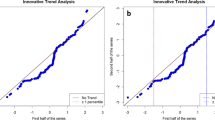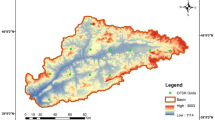Abstract
This research utilizes DrinC software and some codes developed in MATLAB software for calculating the drought indices and determination of trend of climatologic and hydrologic time series data using different nonparametric Mann–Kendall trend tests. The time series data used in this research include the minimum, mean and maximum monthly temperatures, monthly precipitation, and monthly flow discharge (from 1981 to 2012). These data are pertinent to the Dez watershed climatic and hydrometric stations in southwest Iran. Results of this research show that precipitation has no significant trend, but flow discharge has a decreasing trend. The trends of mean, maximum, and minimum temperatures are increasing in summer and autumn but decreasing in spring. In winter, the trend of minimum temperature is increasing, while the trend of mean and maximum temperatures is decreasing. Standardized precipitation index (SPI) and streamflow drought index (SDI) show that the number and intensity of short-term droughts (with 3 months time scale) are more than the number and intensity of long-term droughts (with 6, 9, and 12 month time scales). Correlation coefficient between SPI and SDI increases as the time scale is increased too.





Similar content being viewed by others
References
Xu K, Milliman JD, Xu H (2010) Temporal trend of precipitation and runoff in major Chinese rivers since 1951. Glob Planet Chang 73(3–4):219–232. https://doi.org/10.1016/j.gloplacha.2010.07.002
Khalili K, Tahoudi MN, Mirabbasi R, Ahmadi F (2016) Investigation of spatial and temporal variability of precipitation in Iran over the last half century. Stoch Environ Res Risk Assess 30(4): 1205–1221. https://doi.org/10.1007/s00477-015-1095-4
Addisu S, Selassie YG, Fissha G, Gedif B (2015) Time series trend analysis of temperature and rainfall in lake Tana Sub-basin, Ethiopia. Environ Syst Res 4(1):25. https://doi.org/10.1186/s40068-015-0051-0
Masih I, Uhlenbrook S, Maskey S, Smakhtin V (2011) Streamflow trends and climate linkages in the Zagros Mountains. Iran Clim Chang 104(2):317–338. https://doi.org/10.1007/s10584-009-9793-x
Abghari H, Tabari H, Talaee PH (2013) River flow trends in the west of Iran during the past 40 years: impact of precipitation variability. Glob Planet Chang 101:52–60. https://doi.org/10.1016/j.gloplacha.2012.12.003
Zamani R, Mirabbasi R, Abdollahi S, Jhajharia D (2017) Streamflow trend analysis by considering autocorrelation structure, long term persistence, and Hurst coefficient in a semi-arid region of Iran. Theor Appl Climatol 129(1–2):33–45. https://doi.org/10.1007/s00704-016-1747-4
Mann HB (1945) Nonparametric tests against trend. Econometrica 13(3):245–259. https://doi.org/10.2307/1907187
Sen PK (1968) Estimates of the regression coefficient based on Kendall’s tau. J Am Stat Assoc 63(324):1379–1389. https://doi.org/10.1080/01621459.1968.10480934
Yue S, Pilon P, Phinney B, Cavadias G (2002) The influence of autocorrelation on the ability to detect trend in hydrological series. Hydrol Process 16(9):1807–1829. https://doi.org/10.1002/hyp.1095
Taxak AK, Murumkar AR, Arya DS (2014) Long term spatial and temporal rainfall trends and homogeneity analysis in Wainganga basin, Central India. Weather Clim Extremes 4:50–61. https://doi.org/10.1016/j.wace.2014.04.005
Kumar V, Jain SK (2011) Trends in rainfall amount and number of rainy days in river basins of India (1951–2004). Hydrol Res 42(4):290–306. https://doi.org/10.2166/nh.2011.067
Subash N, Singh SS, Priya N (2011) Variability of rainfall and effective onset and length of the monsoon season over a sub-humid climatic environment. Atmos Res 99(3–4):479–487. https://doi.org/10.1016/j.atmosres.2010.11.020
Sayemuzzaman M, Jha MK (2014) Seasonal and annual precipitation time series trend analysis in North Carolina, United States. Atmos Res 137:183–194. https://doi.org/10.1016/j.atmosres.2013.10.012
Croitoru AE, Piticar A, Dragotă CS, Burada DC (2013) Recent changes in reference evapotranspiration in Romania. Glob Planet Chang 111:127–136. https://doi.org/10.1016/j.gloplacha.2013.09.004
Gocic M, Trajkovic S (2013) Analysis of changes in meteorological variables using Mann-Kendall and Sen’s slope estimator statistical tests in Serbia. Glob Planet Chang 100:172–182. https://doi.org/10.1016/j.gloplacha.2012.10.014
de la Casa AC, Nasello OB (2012) Low frequency oscillation of rainfall in Córdoba, Argentina, and its relation with solar cycles and cosmic rays. Atmos Res 113:140–146. https://doi.org/10.1016/j.atmosres.2012.05.003
Adib A, Kalaee MMK, Shoushtari MM, Khalili K (2017) Using of gene expression programming and climatic data for forecasting flow discharge by considering trend, normality, and stationarity analysis. Arab J Geosci 10(9): 208. https://doi.org/10.1007/s12517-017-2995-z
Somee BS, Ezani A, Tabari H (2012) Spatiotemporal trends and change point of precipitation in Iran. Atmos Res 113:1–12. https://doi.org/10.1016/j.atmosres.2012.04.016
Tabari H, Somee BS, Zadeh MR (2011) Testing for long-term trends in climatic variables in Iran. Atmos Res 100(1):132–140. https://doi.org/10.1016/j.atmosres.2011.01.005
Ay M, Kişi Ö (2015) Investigation of trend analysis of monthly total precipitation by an innovative method. Theor Appl Climatol 120(3–4):617–629. https://doi.org/10.1007/s00704-014-1198-8
Caloiero T (2017) Trend of monthly temperature and daily extreme temperature during 1951–2012 in New Zealand. Theor Appl Climatol 129(1–2):111–127. https://doi.org/10.1007/s00704-016-1764-3
Gocic M, Trajkovic S (2014) Spatiotemporal characteristics of drought in Serbia. J Hydrol 510:110–123. https://doi.org/10.1016/j.jhydrol.2013.12.030
Du J, Fang J, Xu W, Shi P (2013) Analysis of dry/wet conditions using the standardized precipitation index and its potential usefulness for drought/flood monitoring in Hunan Province, China. Stoch Environ Res Risk Assess 27(2):377–387. https://doi.org/10.1007/s00477-012-0589-6
Zhang Q, Xu CY, Zhang Z (2009) Observed changes of drought/wetness episodes in the Pearl River basin, China, using the standardized precipitation index and aridity index. Theor Appl Climatol 98(1–2):89–99. https://doi.org/10.1007/s00704-008-0095-4
Tabari H, Nikbakht J, Talaee PH (2013) Hydrological drought assessment in northwestern Iran based on streamflow drought index (SDI). Water Resour Manag 27(1):137–151. https://doi.org/10.1007/s11269-012-0173-3
Hao Z, AghaKouchak A (2013) Multivariate Standardized Drought Index: a parametric multi-index model. Adv Water Resour 57:12–18. https://doi.org/10.1016/j.advwatres.2013.03.009
Marofi S, Soleymani S, Salarijazi M, Marofi H (2012) Watershed-wide trend analysis of temperature characteristics in Karun- Dez watershed, southwestern Iran. Theor Appl Climatol 110(1–2):311–320. https://doi.org/10.1007/s00704-012-0662-
Hosseinizadeh A, SeyedKaboli H, Zareie H, Akhondali A, Farjad B (2015) Impact of climate change on the severity, duration, and frequency of drought in a semi-arid agricultural basin. Geoenv Disasters 2(1):23. https://doi.org/10.1186/s40677-015-0031-8
Kumar S, Merwade V, Kam J, Thurner K (2009) Streamflow trends in Indiana: Effects of long term persistence, precipitation and subsurface drains. J Hydrol 374(1–2):171–183. https://doi.org/10.1016/j.jhydrol.2009.06.012
Hamed KH, Rao AR (1998) A modified Mann–Kendall trend test for autocorrelated data. J Hydrol 204(1–4):182–196. https://doi.org/10.1016/S0022-1694(97)00125-X
Guttman NB (1999) Accepting the standardized precipitation index: a calculation algorithm. JAWRA J Am Water Resour Assoc 35(2):311–322. https://doi.org/10.1111/j.1752-1688.1999.tb03592.x
Sönmez FK, Kömüscü A, Erkan A, Turgu E (2005) An analysis of spatial and temporal dimension of drought vulnerability in Turkey using the standardized precipitation index. Nat Hazards 35(2):243–264. https://doi.org/10.1007/s11069-004-5704-7
Angelidis P, Maris F, Kotsovinos N, Hrissanthou V (2012) Computation of drought index SPI with alternative distribution functions. Water Resour Manag 26(9):2453–2473. https://doi.org/10.1007/s11269-012-0026-0
Nalbantis I, Tsakiris G (2009) Assessment of hydrological drought revisited. Water Resour Manag 23(5):881–897. https://doi.org/10.1007/s11269-008-9305-1
Acknowledgements
The authors of this manuscript would like to thank Dr. Reza Zamani and the managers and staffs of civil engineering department and engineering faculty of Shahid Chamran University of Ahvaz for providing the facilities of this study.
Author information
Authors and Affiliations
Corresponding author
Rights and permissions
About this article
Cite this article
Adib, A., Tavancheh, F. Relationship Between Hydrologic and Metrological Droughts Using the Streamflow Drought Indices and Standardized Precipitation Indices in the Dez Watershed of Iran. Int J Civ Eng 17, 1171–1181 (2019). https://doi.org/10.1007/s40999-018-0376-y
Received:
Revised:
Accepted:
Published:
Issue Date:
DOI: https://doi.org/10.1007/s40999-018-0376-y




